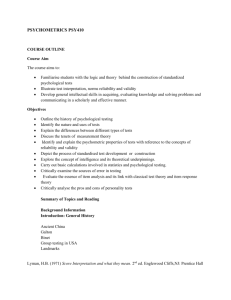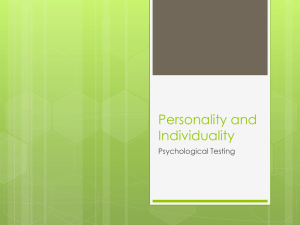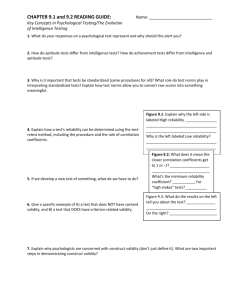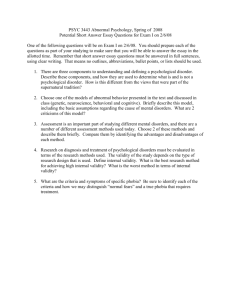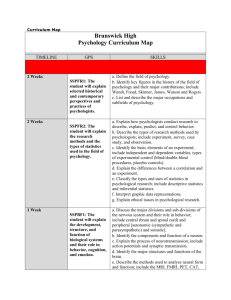Psychological Assessment - Argosy University Dissertation Site
advertisement
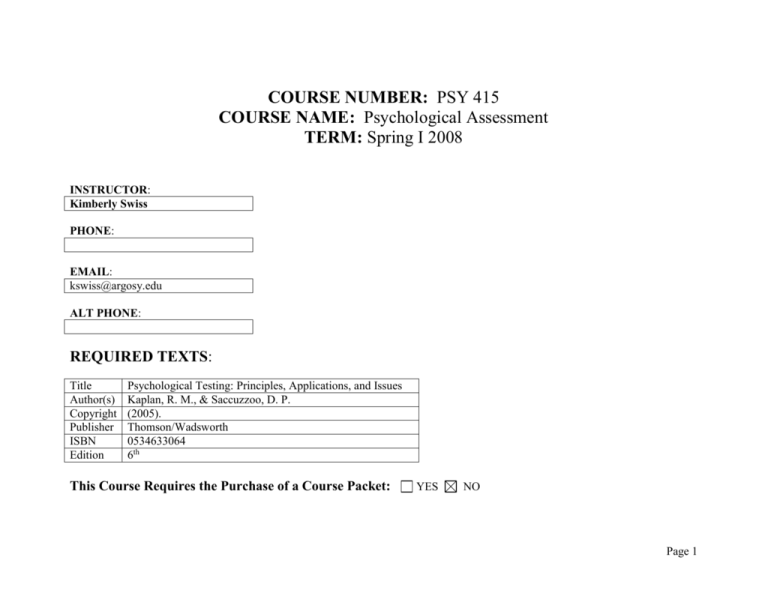
COURSE NUMBER: PSY 415 COURSE NAME: Psychological Assessment TERM: Spring I 2008 INSTRUCTOR: Kimberly Swiss PHONE: EMAIL: kswiss@argosy.edu ALT PHONE: REQUIRED TEXTS: Title Author(s) Copyright Publisher ISBN Edition Psychological Testing: Principles, Applications, and Issues Kaplan, R. M., & Saccuzzoo, D. P. (2005). Thomson/Wadsworth 0534633064 6th This Course Requires the Purchase of a Course Packet: YES NO Page 1 Argosy University COURSE SYLLABUS PSY415 Psychological Assessment Faculty Information Faculty Name: Kimberly Swiss Campus: Contact Information: Office Hours: Short Faculty Bio: Course description: In-depth examination of assessment processes and measurement strategies for aptitudes, intelligence, interests, performance, and personality of diverse population. Ethical, legal, and social issues in test theory, construction, and evaluation. Emphasis on psychometric properties. Course Pre-requisites: PSY210 Required Textbook: Kaplan, R. M., & Saccuzzoo, D. P. (2005). Psychological Testing: Principles, Applications, and Issues. 6th Edition. Thomson/Wadsworth. ISBN: 0534633064 Course length: 7.5 Weeks Contact Hours: 45 Hours Credit Value: 3.0 Program Outcomes: 1. 2. Cognitive Abilities 1.1. Critical Thinking - Given a psychological issue, employ skeptical inquiry and a scientific approach to respond to the issue. 1.2. Information Literacy - Given a research question related to psychology, access information from a variety of sources and select appropriate sources to respond to the question. Research Page 2 2.1. Understanding Research Methods – Given an article about research findings in the field of psychology from a scholarly journal, identify the research methods used and the findings of the article. 2.2. Identifying Research Methods – Identify the appropriate statistical tools and basic research methods in psychology, including research design, data analysis, and interpretation. 3. Communication Skills 3.1. Oral - Effectively present psychological concepts orally as appropriate to the audience. 3.2. Written - Effectively present psychological information, in writing, using software and style appropriate to the audience. 4. Ethics/Diversity 4.1. Ethics - Identify the issues and challenges related to ethics in the field of psychology. 4.2. Diversity - Identify the issues and challenges related to diversity in the field of psychology. 5. Knowledge of the Field 5.1. Foundations – Recognize the major concepts, theoretical perspectives, empirical findings, applications, and historical trends in psychology. 6. Knowledge of Applied Psychology 6.1. Apply psychological principles to personal, social, and/or organizational issues. 7. Interpersonal Effectiveness Students will develop and improve positive relationship skills via effective communication, respect for others, appreciation of diversity and cultural sensitivity, and awareness of their impact on others. 7.1 Apply active listening communication skills in interpersonal and organizational scenarios to establish empathetic, collegial relationships that facilitate consensus building in working toward common goals and are appreciative of diversity and culture. 7.2 Analyze the importance of effective nonverbal communication skills in developing strong interpersonal and organizational relationships that are culturally sensitive and respectful of diversity. 7. 3 Solicit and utilize feedback to develop adaptable strategies of facilitating dynamic interpersonal and organizational relationships. 7. 4 Analyze the impact of technological advances on communication within interpersonal and organizational relationships. 7. 5 Utilize effective communication and relationship skills in order to promote the growth of others and effect change. Course Objectives: 1. Demonstrate an understanding of the nature and use of psychological tests and the historical antecedents of modern testing practices. (Program Outcome(s): 5) 1.1. Define the basic concepts and nature of psychological and educational tests. 1.2. Distinguish between structured personality tests and projective personality tests. 1.3. Define the terms achievement, aptitude, and intelligence, and identify a concept that can encompass all these terms. 1.4. Distinguish between ability tests and personality tests. 1.5. Explain what a normative or standardization sample is and why such a sample is important. 1.6. Identify the major developments in the history of psychological testing. 1.7. Explain the relevance of psychological tests in contemporary society. Page 3 2. 3. 4. 5. Identify and explain the methodological and psychometric principles of psychological assessment instruments including test theory, test construction, validity, and reliability. (Program Outcome(s): 3.1, & 5) 2.1. Discuss the properties of scales of measurement, descriptive statistics, and correlation. 2.2. Express the extent to which two measures are associated and the nature of the relationship by using visual graphs. 2.3. Describe how a regression line describes the relationship between two variables. 2.4. Identify how norms are created and how they are used to examine reliability and validity. 2.5. Explain what measurement error is and how it interferes with scientific studies in psychology. 2.6. Explain how reliability affects psychological testing. 2.7. Discuss different types of validity. Articulate major theoretical, social/cultural, and ethical/legal issues in ability testing; personality testing; and assessment of interests, styles, and types. (Program Outcome(s): 3.1, & 5) 3.1. Discuss the Stanford Binet Intelligence test and Wechsler tests, and differentiate between them and other tests of ability. 3.2. Describe at least one personality test and one interest inventory. 3.3. Describe intelligence and intelligence quotient. 3.4. Discuss social/cultural and ethical/legal issues in ability testing, personality testing, and assessment of interests, styles, and types. Review and analyze differences among procedures and considerations for testing individuals and groups; individuals with special needs; and persons at various developmental stages. (Program Outcome(s): 3.1, 4.2, & 5) 4.1. Explain how a researcher might identify biased results based on the notion of adverse impact. 4.2. Discuss different types of interviews and the impact an interviewer has on the assessment process. 4.3. Identify some of the characteristics of effective interviewing. 4.4. Appreciate the role of cultural, ethnic, and socioeconomic factors in the interview process. 4.5. Compare and contrast individual and group tests. 4.6. Describe group tests used for students in kindergarten through the twelfth grade. 4.7. Discuss group tests for college entrance and graduate school entrance. 4.8. Discuss modifications of administration based on an individual’s development level or special needs, such as sight and hearing impairments. Examine and articulate differences in response-types of instruments including self-report interviews or paper/pencil tests; projective tests; and observational assessments. (Program Outcome(s): 3.1, & 5) 5.1. Describe types of item formats commonly used in objective classroom examinations. 5.2. Evaluate the strategy used in the construction of MMPI/MMPI 2 and MMPI-A, its strengths and weaknesses, and when it is used. 5.3. Describe the projective hypothesis. 5.4. Analyze the Rorschach test, principles of its administration and scoring, and its pros and cons and appropriate usage. 5.5. Analyze the TAT stimuli, administration procedures, the factors that should be considered in its interpretation, and when it is used. 5.6. Recognize the issues surrounding observational assessment techniques. Assignment Table Page 4 1 Topics Definition of Psychological Testing History of Psychological Testing Aptitude, Achievement, and Intelligence Ability and Personality Tests Cultural, Legal, or Ethical Issues Readings Kaplan & Saccuzzo Chapter 1 Assignments Discussion Questions: 1. Shelley is in college studying for a degree in psychology. As part of an assignment, she is required to create a technique that measures the personality of others. Shelly develops a list of questions pertaining to individual choices and attitudes. Her rationale is that by asking a person such questions, she can gain an insight into the person’s personality. a. Do you think that the list of questions that Shelley has come up with constitutes a psychological test? Provide reasons for your answer. b. Discuss the kind of test questions you would create in response to the same assignment. 2. Most colleges and universities have a committee dedicated to approving human participant research. In the past, certain types of research undertaken using human participants have been considered unethical. You may refer to the Stanford Prison study at the following Web site: http://www.prisonexp.org/ Based on the findings of this study and others, discuss what you consider as important prerequisites for conducting research on human behavior by using human participants. 3. Gemma is an Asian-American woman studying psychology at a graduate school in New York. She has been in the United States for only a year. As part of her testing class, she has to develop an assessment technique — by using a structured or unstructured format — to measure aggression in individuals. The test must contain questions that are accurate enough to assess different levels of aggression. a. Based on your understanding of cultural issues in psychological testing, answer the following questions: b. How might Gemma’s assessment differ if she were going to measure individuals of different cultural backgrounds, such as Asian, Latin Americans, and Native Americans? c. Will Gemma’s presentation of test content be different in comparison to other students’, who is born and raised in the United States? Provide reasons for your answer. Page 5 Assignments: 1. Aptitude and Achievement Sam has two important tests on one day. One is the end-of-the-year test, which will decide whether he passes or fails the class. The other is a test of music, based on which the music teacher will decide whether or not Sam has musical ability. a. Which of Sam’s two tests is an aptitude test, and which is an achievement test? b. Differentiate between aptitude and achievement. c. Identify the potential problems in using these tests in Sam’s case. d. What would be the right kind of questions to be included in a test assessing musical ability? e. What would be the right kind of questions to be included in a test assessing mathematical ability? 2. 2 Need for Statistics Scales of Measurement Techniques of Representing Data Kaplan & Saccuzzo Chapter 2 Final Project The test is for measuring intelligence. Refer to the information provided about the test, and perform the following tasks: a. Provide a fictitious name to the test that best describes the nature of the test. b. Discuss what intelligence means to you. c. Differentiate between intelligence and personality. d. Differentiate clearly between ability tests and personality tests by providing a few examples of each. e. Compare personality, intelligence, and aptitude. f. Differentiate between this test and educational tests. Provide reasons for your answer. Discussion Questions: 1. A high school teacher wishes to tabulate and create a graph of the results of a final exam for the 15 students in her class so that she can show the principal their performance visually. a. Identify the best technique to represent this data. Provide reasons for your answer. b. If she wanted to showcase to the principal that the performance of her Page 6 c. class has improved, which measure of central tendency would be the most effective? What factors are important in deciding the most appropriate measure of central tendency? 2. A high school teacher assesses the performance of her class by using mode as the measure of central tendency. In other words, she decides that because 10 out of 35 students in her class have scored 80%, her class on the whole has done well. a. How can the high school teacher better evaluate whether the class is doing better or worse? Provide reasons for your answer. b. Identify the measure that the teacher should use. Provide reasons for your viewpoint. c. Provide examples of how the mean, median, and mode might be misused when trying to solve real-life problems. 3. Mark Twain is credited with saying, “There are lies, damn lies, and statistics.” What was he referring to? a. If statistics are sometimes used to confuse or manipulate others, why should we study them at all? Provide logical reasons to support your views. Assignments: 1. Norms Standard scores, which are the format of the results in psychological assessment, are simply “the degree to which the observed score matches the norming sample.” For example, a standard score of 10 when the mean is 10 indicates that the observed score matches exactly at the 50%ile of the norming sample. This means that the norming sample is our ruler against which other scores are measured. a. Discuss the way norms are developed. b. Analyze the mechanisms in place to ensure that the norms selected are accurate for the test in question. c. Address random sampling, random assignment to groups, and Page 7 d. e. matching in your answers. Explain why these concepts are so essential. Explain the problem of using the wrong scale for certain calculations. Analyze how misinterpreting the wrong scale can result in incorrect interpretations. 2. 3 Correlation and Regression Theory and Types of Reliability Sources and Measures of Error Kaplan & Saccuzzo Chapter 3 Chapter 4 Final Project The test you have named is based on the ordinal scale of measurement. The ordinal scale allows you to rank individuals or objects without attaching any meaning to the differences between ranks. a. Compare the ordinal scale of measurement with other scales of measurement, providing examples of each. b. Give reasons an intelligence test could be based on any of the other scales of measurement. c. Examine how scales of measurement should differ between ability tests and personality tests. Discussion Questions: 1. Assume that there is a correlation of 0.80 between family discord and obesity in adolescent girls. How would you interpret this? a. What are some possible reasons for this correlation to exist? b. Provide relevant examples of positive and negative correlation. Analyze how the examples might be represented on a regression line. 2. A research study examined the feeling of happiness two groups of students had toward their instructor in one of two teaching formats ― online and on-ground. Classical Test theory tells us that “X,” the observed score, is the true (T) score plus error (E) — X = T + E. Explain the concepts of X, T, and E by using the aforementioned fictional study, three sources of error, and one measure that we use statistically to “control” for error. 3. Often, correlation is mistaken for causation. For example, childhood sexual abuse and dissociative personality disorder have a strong correlation as do family dysfunction during childhood and emotional Page 8 issues in adulthood. a. Provide reasons why you might view these as correlation not causation. b. Theoretically, how should you evaluate whether or not a causal factor truly exists? Assignments: 1. Reliability Reliability is one of the essential requirements of a psychometrically sound test. Discuss why this is so. a. What would it mean if a test were unreliable? b. Identify some methods used to measure the reliability of a psychological test. c. Analyze how you would go about increasing the reliability of the test. 2. 4 Definitions and Types of Validity Validity Coefficients Reliability vs. Validity Kaplan & Saccuzzo Chapter 5 Final Project To gauge the level of the test-retest reliability of the test, suppose you administer it to a group of 10–15 year olds twice over a period of two weeks. While administering the test, you’ll observe that the test is low on reliability because it yields different results when you administer it at different times to the same subjects. a. What factors you think are responsible for low test-retest reliability? b. Do you think the test reliability was affected by the items within the test or other more extraneous factors? c. What is the best way to assess the test-retest reliability of a test? d. What do you think are the sources of error for this type of reliability? Describe ways in which you would mold the test to make it higher on reliability. e. How do you think reliability affects psychological testing? f. How do you think administering the test to a group that it was not intended for affects the results? Discussion Questions: 1. The Good Guys, an electronics store, has the slogan, “The Good Guys: We’ve Got to be Good.” Page 9 The implication might be that “They’ve Got to be Good” because they are named “The Good Guys.” a. Is it necessarily true that if named “Good,” they must be “good”? b. What is the primary issue with this slogan? Explain where the store’s argument loses validity. c. In addition, provide a slogan of your own for another product that would have a high level of validity. 2. Assume you are planning to apply to graduate school. The admissions committee would use many selection criteria to either accept or deny you admission. a. What measure do you feel would be the most and which the least valid for basing an admissions decision? Explain your choice. 3. An eighth-grade history test is administered to sixth-grade history students. The questions are all history-related. The students, however, soon realize that the items on the test are not relevant to the course covered by them that year. A spelling test consists of 100 items. The students are required to correct the spellings of all the 100 words. The test does not have a time limit. A test measuring interest in art guarantees that people who score high always end up doing exceedingly well in art competitions. a. Describe the type of validity indicated in each example. b. Discuss why you think the three examples indicate the three specific types of validity? c. Analyze any two types of validity by providing your own examples. Assignments: 1. Understanding Validity Everyday, we are assaulted with truths — people trying to convince us to do things, such as spend money or time or vote, based on their arguments that they claim are valid. a. Choose one of these arguments from your life, and evaluate its validity. b. Address the different types of validity, and discuss the skills needed to defend against invalid arguments. Page 10 c. d. Address the topics from Weeks 1–3, including psychological testing, statistics, and reliability, and analyze how they relate to the evaluation of validity. Explain how reliability is connected to validity in this situation. 2. 5 Principles of Test Construction Writing and Evaluation of Test Items Item Analysis Test Administration Interviews as a Method of Testing Adverse Impact of Cultural Bias Kaplan & Saccuzzo Chapter 6 Chapter 7 Chapter 8 Final Project The test is low on content validity, but extremely high on face validity. Identify the issues in the test that contribute to its being low on content validity. a. List the advantages and disadvantages of having a test with high face validity. b. Create three test questions that might have both high content and face validity for this test. c. Discuss how norms help assess reliability and validity. d. Suggest ways in which you would define norms for a test of intelligence. Discussion Questions: 1. Dr. Gorsuch along with colleagues is conducting a study to observe men approach women in a bar. They are unobtrusively recording the number of times a woman makes eye contact and correlating this with when she eventually accepts an invitation to dance ― they feel this might be an indication of attraction. What are some strengths and weaknesses of this method? a. Describe some of the advantages and disadvantages associated with behavioral observation techniques. b. Provide examples to support your views. 2. Assume you are a researcher interested in measuring personality attributes associated with being an astronaut. a. Identify the several test items and the methods for analyzing the appropriateness or inappropriateness of including them in a test made to screen-in or screen-out potential candidates. 3. Many psychologists believe that understanding and sharing the culture of a client is necessary for proper understanding of the client. a. If you were to interview a person of different ethnicity or culture, Page 11 b. c. d. e. identify the difficulties that you might encounter. Can these be overcome, or should you refer to another professional? Discuss potential cross-ethnic, cross-cultural, and cross-class factors that may affect interview validity. How would you handle such an interview? Analyze how the potential interviewee might view you. Assignments: 1. Item Formats and Item Analysis Create a 10-question test on any subject of your choice, and post it in the Discussion Area. Refer to two of your classmates’ tests, answer the following questions based on their tests, and give them feedback: a. What are the formats of their tests? b. What do you think their tests seek to measure? c. What do you view as the strengths and limitations of the type of formats they chose to use? d. What are your thoughts about the way their questions are worded? e. How can the test-writers improve their questions such that they get the information they seem to want? f. Provide examples on how to possibly use the test data generated from their tests. 2. 6 Intelligence: Theories and Kaplan & Saccuzzo Final Project The test you have been referring to over the past few weeks is essentially a verbal test. You feel however that the age group being targeted by the test would be much better assessed by using a variety of presentations, rather than by just being verbal. a. Describe how else you might measure intelligence by using different test formats, and explain why. b. Compare the presented psychological test with the interview assessment technique. c. Provide examples of any situations in which the interview provides an equally effective measure as a verbal test such as the one provided. d. Examine how culture and socioeconomic factors affect the interview process. Discussion Questions: Page 12 Constructs Intelligence Quotients Stanford-Binet Intelligence Test David Wechsler’s Tests Ethical Issues in Intelligence Testing Chapter 9 Chapter 10 1. The Peckham Decision dictates that school psychologists in California may not use intelligence testing on African-American children to determine special-education placement. This is due to a cultural bias because of which a large percentage of African-Americans were being placed in the Educable Mentally Retarded category. a. How might this decision help and potentially harm African-American students with special educational needs? 2. The Wechsler’s Adult Intelligence Scale, the Stanford-Binet Intelligence Test, and other tests have been revised several times over the past decades. In fact, it is considered unethical for a psychologist to use a test that has been revised for more than one year. a. Identify the reasons for revising these tests. Substantiate your reasons with examples of problems that might arise if these tests were not revised. 3. To measure intelligence, we must transform behavior, such as defining words or putting puzzles together under a time limit, into standard scores. For example, Spearman advanced the concept of g, a single score that represents overall intelligence. Others have argued that intelligence cannot be captured by just one number. a. Define the concept of IQ. Analyze its strengths and limitations. b. Analyze the usefulness of knowing your own, your clients’, or your students’ IQ. Assignments: 1. Intelligence Intelligence can be broadly thought of as the ability to navigate successfully and succeed in the world. We have all met some people we think of as intelligent and some that might be less so. a. Outline your own theory of intelligence. Assume you were to design a test to measure this intelligence, and develop some representative tasks that would gauge it. There should be at least 6 representative tasks to gauge intelligence. Page 13 b. Discuss what this intelligence could do for a person in life, and how people without it would be somewhat less well equipped. 2. 7 Constructing Personality Tests Projective Testing vs. Objective Testing Projective Techniques Personality Assessment: Psychometrics Ethical Issues in Personality Testing Kaplan & Saccuzzo Chapter 13 Chapter 14 Final Project Now, it is time for you to report all that you have learned in the previous weeks about psychological testing. While doing so, describe the information that any test constructor should know before setting about creating items for a test. a. Develop items for an intelligence test, keeping in mind the considerations listed in previous assignments. Pay special attention to how well your items seem to measure intelligence. Ensure that you have created at least 10 test items. b. Should your test items include verbal or performance items, or both? Differentiate between the two and provide reasons for your answer. c. Refer to any existing tests of intelligence, such as the Stanford Binet or the Wechsler tests, to get ideas for your items. d. List the aspects of the intelligence tests you have read about that you feel are most appropriate for measuring intelligence. What parts of those tests seem the weakest? e. State the theory of intelligence that you would base this test on so that it comprehensively measures of intelligence. Provide reasons for your answer. Discussion Questions: 1. Scholars have struggled with defining, describing, and measuring personality. Indeed, if you were to describe yourself, how easily could you do it? It would probably take a book to truly describe all of your roles, desires, strengths, needs, and other aspects of who you are. For this reason, many personality inventories have been criticized for their potential inadequacy or lack of validity. a. Discuss the reasons why personality needs to be assessed. b. How would you increase the assessment's validity? 2. Personality can be thought of as a set of behaviors that are consistent in an individual over time. Page 14 a. b. c. 3. What are some ethical considerations regarding personality assessment? What pitfalls might exist? What special considerations might you take into account when using projective versus objective personality tests? How effective are projective techniques in preventing ethical violation of a client in personality testing? Provide reasons for your answer. One way to evaluate personality is to use projective tests, which rests on several assumptions. a. Define the projective hypothesis, and analyze how the MMPI-2 and Rorschach tests utilize that hypothesis to test subjects. b. Do you think this is an accurate way of evaluating a person? Why or why not? Assignments: 1. Analyzing the Rorschach Inkblot Technique Controversy surrounds the validity of certain personality tests, including the Rorschach Inkblot Test. Pundits argue that the Rorschach test results in over-identifying mental problems and is unreliable and invalid. Scholars in favor of the Rorschach test argue that it is one piece of evidence in the whole battery, and criticisms are unfounded or controllable. a. Construct a scenario, and present both sides of the argument where the Rorschach test could be used to help and hurt the individual being tested. b. Cite relevant Web sites or journal articles in your argument, and comment on the sources of validity. 2. Final Project While analyzing this test, you realize that it is not applicable to all cultures. You also feel that the test questions are more appropriate for certain sections of U.S. society and not for others. Keeping this situation in mind, answer the following questions: a. How are test results of a particular test potentially biased by assessing ethnic groups outside of the normative sample used in the development of the test? b. What complications might occur in a multiethnic society such as the Page 15 8 Developmental Stages: Ability Tests Ability Tests for Special Needs Issues in Psychological Testing Assessment vs. Testing Future of Psychological Testing Kaplan & Saccuzzo Chapter 11 Chapter 21 U.S. with respect to developing tests and obtaining normative samples? c. What are the other issues that may occur while administering this intelligence test to the specified age group in terms of education and socioeconomics? d. Are these considerations equally important in personality tests? e. While creating and administering personality tests, is there a greater chance of cultural differences in test-takers creating errors in reliability and validity of the test? f. Provide reasons for your answer. Discussion Questions: 1. Intelligence testing is an integral part of an assessment battery for an individual with learning disabilities and developmental delays. a. What considerations might you have when assessing an individual with potential learning or developmental problems? b. How might group versus individual or interview versus formal formats affect the test results? c. You would have taken group tests, such as SAT or CAT yourself; what are your thoughts on the validity of these tests? 2. Jeff is a Masters-level intern in a community clinic and has been asked by his supervisor to administer an intelligence test to students of different age groups. The three age groups he will be administering the test to are: First graders. Fifth graders. Tenth graders. a. What suggestions would you make to Jeff regarding the choice of test? If there were an intelligence test available in group format, which Jeff could administer, would you recommend that test? What would you base your decision on? Analyze the pros and cons of group versus individual tests in this situation. As students get older, do you think verbal items or performance items b. c. d. Page 16 assess their intelligence more accurately? Substantiate your answer with reasons. 3. Psychologists work in many fields and assess individuals in various ways. The field of psychology has changed dramatically in the past 15 years and continues to evolve with time. a. Based on new technologies and changing ethics and laws, where do you see the field of psychological testing a decade from now? b. What are the main issues you foresee affecting the position of psychological testing in the future? Assignments: 1. Final Project The test you have been referring to over the past eight weeks needs tremendous improvement that you have analyzed and provided explanations for. Now, you are faced with the additional task of suggesting changes to the test to ensure that it no longer faces the same problems. To ensure that the test is psychometrically sound, answer the following questions: a. List the considerations you would have to ensure the test is better than before? How you might improve validity and reliability of the test. b. Keeping in mind that this is a verbal test of intelligence, what improvements might you make in the administration of the test? c. If you were to renorm the test for different ages and developmental stages, what considerations must you take into account while modifying the test items and changing the normative sample? List the considerations you would adhere to while modifying the test items and norming sample, if you were creating the same test as the fictional test for different developmental stages. d. How might you improve the test’s ability to appropriately assess different ethnic and cultural groups? Page 17 Grading Criteria Grading Scale Grading requirements A 100 -93 A- 92 – 90 B+ 89 – 88 B 87 – 83 B- 82 – 80 C+ 79 – 78 C 77 – 73 C- 72 – 70 D+ 69 – 68 D 67 – 63 D- 62 – 60 F 59 and below Attendance/participation Weekly Assignments Final paper Optional Optional 25% 20% 35% 10% 10% 100% Library: All resources in Argosy University’s online collection are available through the Internet. The campus librarian will provide students with links, user IDs, and passwords. Library Resources: Argosy University’s core online collection features nearly 21,000 full-text journals and 23,000 electronic books and other content covering all academic subject areas including Business & Economics, Career & General Education, Computers, Engineering & Applied Science, Humanities, Science, Medicine & Allied Health, and Social & Behavior Sciences. Many titles are directly accessible through the Online Public Access Catalog at http://library.argosy.edu. Detailed descriptions of online resources are located at http://library.argosy.edu/misc/onlinedblist.html. In addition to online resources, Argosy University’s onsite collections contain a wealth of subject-specific research materials searchable in the Online Public Access Catalog. Catalog searching is easily limited to individual campus collections. Alternatively, students can search combined collections of all Argosy University Libraries. Students are encouraged to seek research and reference assistance from campus librarians. Information Literacy: Argosy University’s Information Literacy Tutorial was developed to teach students fundamental and transferable research skills. The tutorial consists of five modules where students learn to select sources appropriate for academic-level research, search periodical indexes and search engines, and Page 18 evaluate and cite information. In the tutorial, students study concepts and practice them through interactions. At the conclusion of each module, they can test their comprehension and receive immediate feedback. Each module takes less than 20 minutes to complete. Please view the tutorial at http://library.argosy.edu/infolit/ Academic Policies Academic Dishonesty/Plagiarism: In an effort to foster a spirit of honesty and integrity during the learning process, Argosy University requires that the submission of all course assignments represent the original work produced by that student. All sources must be documented through normal scholarly references/citations and all work must be submitted using the Publication Manual of the American Psychological Association, 5th Edition (2001). Washington DC: American Psychological Association (APA) format. Please refer to Appendix A in the Publication Manual of the American Psychological Association, 5 th Edition for thesis and paper format. Students are encouraged to purchase this manual (required in some courses) and become familiar with its content as well as consult the Argosy University catalog for further information regarding academic dishonesty and plagiarism. Scholarly writing: The faculty at Argosy University is dedicated to providing a learning environment that supports scholarly and ethical writing, free from academic dishonesty and plagiarism. This includes the proper and appropriate referencing of all sources. You may be asked to submit your course assignments through “Turnitin,” (www.turnitin.com), an online resource established to help educators develop writing/research skills and detect potential cases of academic dishonesty. Turnitin compares submitted papers to billions of pages of content and provides a comparison report to your instructor. This comparison detects papers that share common information and duplicative language. Americans with Disabilities Act Policy It is the policy of Argosy University to make reasonable accommodations for qualified students with disabilities, in accordance with the Americans with Disabilities Act (ADA). If a student with disabilities needs accommodations, the student must notify the Director of Student Services. Procedures for documenting student disability and the development of reasonable accommodations will be provided to the student upon request. Students will be notified by the Director of Student Services when each request for accommodation is approved or denied in writing via a designated form. To receive accommodation in class, it is the student’s responsibility to present the form (at his or her discretion) to the instructor. In an effort to protect student privacy, the Department of Student Services will not discuss the accommodation needs of any student with instructors. Faculty may not make accommodations for individuals who have not been approved in this manner. The Argosy University Statement Regarding Diversity Argosy University prepares students to serve populations with diverse social, ethnic, economic, and educational experiences. Both the academic and training curricula are designed to provide an environment in which students can develop the skills and attitudes essential to working with people from a wide range of backgrounds. Page 19
